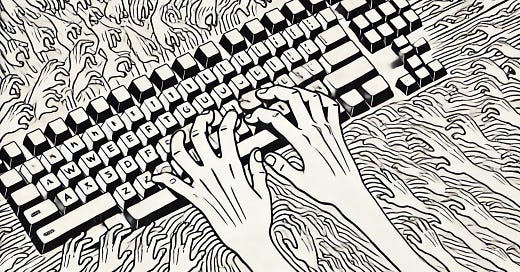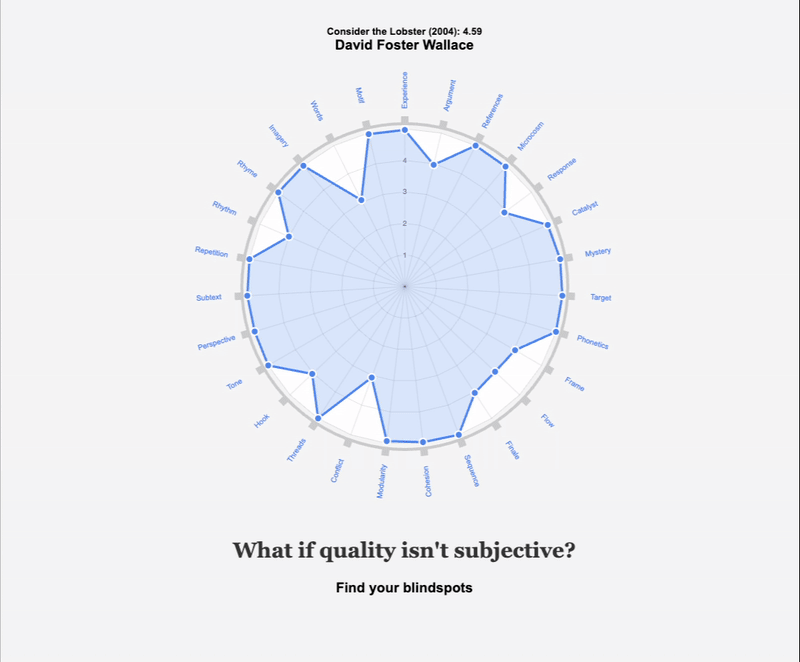Welcome to Essay Architecture. If you’re new to this Substack, you might want to start with A Pattern Language. Today I’m sharing a short essay to introduce a new experiment (I’m livestreaming Friday at 9AM). At the bottom you’ll find updates on the essay analysis software I’m building, and some links to recent writing.
Wordcels are the least likely breed to show their face on camera, and so it’s ironic that Substack is trying to turn its writers into streamers. I got an email this week: “Launch your own live video show on Substack.” The last year has seen a dizzying array of video tools (podcasts, clips, transcriptions, livestreams, etc.) and so at the bottom of any of these feature updates you’ll find a grumbling cohort of prose-only creators.
Substack is putting in a lot of effort to help you build a multimedia empire, but most of us just want to keep our blog alive. Are they betraying their core user? Personally I’m not so grumpy about video. I’m keen to experiment. Even if it brings an influx of TikTokers, I'm confident Substack won’t turn into an NPC hellhole. Still, this place was founded by writers, and so I’ve been wondering—how might writers hijack video?
They could aim their phone at their monitor and just stream themselves drafting in Google Docs with size 36 font. For a delusional moment, I imagined this could be a symbolic way for writers to take back their medium—at 5pm ET tomorrow, we’ll all live-write at the same time and crash the app—but then I remembered that writing is incredibly boring to watch.
Writing is mostly pausing, thinking, editing, deleting, procrastinating, and starting over. In Essay Writing as Personal Sovereignty, I shared that it took me 45 hours to write a 2,700 word essay. This comes out to 1 word per minute (wpm). If writing wanted to resemble a live performance, a writer would have to write as fast as a reader reads: +200 wpm. The average writer types at 40 wpm. This 5x difference explains why live writing isn’t a genre. Our fingers are the bottleneck. But what if I trained to be a competitive typist?
When I was in elementary school I’d hang out in the computer lab and spend hours doing free typing tests for fun. This might be a false memory, but I remember cracking 200 wpm as a 5th grader. I took one now and only got 124 wpm. I’m rusty. Worth noting, this is not the speed of thinking, but the speed of mindlessly typing over random sentences—you’re so indexed on speed that it might say, “the quick brown fox jumped over the lazy dog and fucked a pig,” and you wouldn’t notice.1
So two Fridays ago I streamed on Substack. I bought a $17 mount from Amazon to position my phone camera. I set my font to 3x. The “moire effect” distortion is part of the charm. I said I’d only try it for 15 minutes, but ended up going for 50 and almost missed my train (on Valentine’s Day). In that time I wrote 2,700 words (!) which comes out to an average of 54 wpm. I took some short breaks to prevent wrist failure, and so I imagine the general sustained pace was more like 80-100 wpm. Even if that’s 2x slower than skim-reading, it’s 50x faster than how I usually write. This is by no means a come-behind-the-scenes-to-watch-how-I-actually-write experience. This is a social experiment to shock me out of editor-brain.
Maybe you’ve heard of “The Most Dangerous Writing App,” a clever tool to get writers out of their head. You set a timer (10 minutes) and your text starts to fade red when you stop typing. If you stop for 5 seconds, the whole document deletes itself. I’ve done this dozens of times to get an initial draft on the page, and I found that live writing to 38 people on Substack Live is more intense. I’d rather lose all my work than expose myself as a fraud who can’t write. Writing, live and unedited, is something like streaking. You’re naked but moving fast enough to blur the parts. It’s liberating, but likely annoying.
Did anyone enjoy my stream? I’m not sure if 38 people stuck around for every sentence or if 300 people cycled in and out for the spectacle. I only got two pieces of feedback: one said, “I’ve never seen anyone do that before,” and another said “good ASMR content” (meaning you can get off to the sound of my mechanical keyboard without even having to read).
Maybe the important question here: did I enjoy doing it?
I experienced a flow state unlike anything I’ve ever felt. Like a roller coaster, I almost vomited and I’m ready to go again. I wasn’t queasy from nerves. I got queasy from concentrating so hard that I didn’t blink for 10 minutes. Writing at high speed means you have to simultaneously map out the next sentence while you chisel the one you’re on. It’s a 100% bandwidth kind of activity. The critical difference between this and stream of consciousness drafting is the live audience. It’s a performance. When you realize there’s zero lag between a keystroke and the stranger reading it, you tap into Jack Kerouac mode, but without the amphetamines.
There are some obvious reasons why speed writing in public is a bad idea:
Truman Capote criticized Kerouac by saying, “that’s not writing, that’s typing.” If you don’t stop and recursively loop thought back on itself, there’s a limit to the density and elegance of your prose. On the Road was an untouchable heap until Malcolm Cowley edited it. You might even say a core reason why LLMs suck at writing (for now) is because they write way too fast. They can’t pause to re-evaluate the prompt, context or outputs. Once they’ve mathematically matched your question with the trillions of words they’ve guzzled, they can only barrel forward, blindly.
Now, amplify the perils of speed with misaligned social incentives: do I go more viral if I let the crowd control me? Is this some kind of literary AMA where the audience sets the topic for the next paragraph? Is it worth being the inventor of MMCCP (massively multiplayer crowd-controlled prose)? If I hack Substack Live and go wildly viral and have thousands of new viewers per day—will this encourages me to speed write at 100 wpm for 6 hours a day w/o break like a high-brow Pinkydoll? How long until my wrists permanently conk?
Risk aside, I’d like to find the sweet spot with speedwriting because it’s the perfect counterpoint to Essay Architecture. My main project is basically an editing philosophy. It’s slow. It’s cerebral. It runs counter to the aesthetic of speed that’s blooming on Substack. I see more and more Notes about not re-reading your work, keeping the typos, and letting essays spiral in random directions. Speed might make a terrible main-mode, but a terrific sub-mode: it’s a specific way to practice. If you want to get good at any game, you need to find enjoyable sub-games to isolate skills. I find the more contradictory the sub-games, the better. Sometimes I publish logs to my website w/o re-reading them; sometimes I gather 20 beta-readers and spend 100+ hours editing. Sometimes I’ll take 3 hours to score a classic essay on a 405-point rubric; and sometimes I livestream at 54 wpm without a plan.
The strictly slow get constipated with theory. The strictly fast can never give form to verbal diarrhea. But when you shift from slow to fast, you turn abstract concepts into embodied knowledge.
The goal of Essay Architecture isn’t to cram your head with rules, it’s to forget them. The more you train, the more coherent the improv.
A big and possibly unexpected influence of mine is the Grateful Dead. If you asked Rick Rubin why they’re so good, he’d say, “They trust their intuition, embrace imperfection, pay attention, and chase real moments.” All true. But they can only operate in their realm of creative ooze because they were so disciplined when they started. Jerry Garcia was a competition banjo player who practiced scales 10+ hours a day. Phil was classically trained. Mickey wrote a book on rhythm. The early Dead even kicked out young Bob Weir because he didn’t practice hard enough—he had to work his way back into the band. Years of study will shape your intuition so that you can eventually operate with your mind almost completely off. You get out of your head by training your head. Even Kerouac wrote a million words of traditional novels over 10 years before he dared write On the Road.
Updates:
Livestreaming on Friday at 9am ET.
I’ll be on at 9am ET tomorrow, and from then on, who knows. I think I’m going to riff on “Writing in 2045,” but anything could happen. To start, I want to keep this experiment as loose as possible. Substack is encouraging “live shows” (ie: watch me riff every Friday at Xpm ET). I’d rather it be unannounced, at random hours, hopefully multiple times per day, sometimes 15 minutes, sometimes 2 hours, sometimes NPC mode, sometimes in control.
Want to try the Essay Architecture app?
I still have another few months of polish, refinement, and testing before I launch this in full, but I want to start onboarding writers now. The core flow works. You upload a draft and it runs 120 prompts over it, finds your blindspots, and then orients you into a 42,000 word wiki. My plan is to onboard writers 1:1 over Zoom. We’ll upload your draft, walk through the app together, find UX hiccups, and talk big picture around the features you need. I’ll give you some free credits so you can continue using it after our call. In these early days, I’ll grow the user base as slowly as possible. I’ll onboard 1-2 writers per day and rapidly implement their best suggestions for the next day’s onboarding. If you want to help shape this, the button below leads you to a form with ~10 questions. From there I’ll follow up with a Calendly link sometime in the next few weeks.
Published since last update
This is my 4th post here in ~50 days, which is close to my 3x a month goal for 2025. I’ll be publishing a few more times here in the next week to meet my February goals. Essay Club is helping me with my own practice, and our group’s publishing rate in January was 67% (pretty good, considering how hard it is to stay consistent). If you want to start a long-term writing habit, check it out or send me a message.
Year of the wiki (about the essay app I’m building)
Best American Essays? (a review of the 2024 essay anthology)
Thank you for the roses (a long form essay about NPC streamers on TikTok)
Logloglog (155 notes from January 2025) 🔒
Footnotes:
I’m slowly putting together my own usage guide, and I’m undecided on when, how often, or why to curse. I suppose you don’t need a reason, but it always feels like a decision. Charles Dickens said to never swear. But
cursed over 1,000 times in “...the subtle fuck of fuck fucking fuck fuck…” and even included a “wall of fucks.” Every situation is different. Maybe the decision is clear if your blog falls neatly in the “professional goals” or “artistic expression” category, but what if it’s both? It feels wrong to self-censor the swear words in my first draft out of principle. That is a cowardly default. And so this means I need to be very specific on when and I do and don’t curse. Maybe the answer isn’t so different from most writing advice: “don’t use cliches and be specific.” So I’ve decided I’ll never use the f-bomb for anger or hyperbole or cliche (no “f*ck you!” or “that was so f*cking lame,” or “f*ck around and find out.”) These are tired ways to use special words. So I vow to only curse when it’s unexpected, like within theoretical farm situations featured inside of speed typing tests that no one will notice.






Cheryl Strayed is the queen of using the word fuck. She uses it sparingly, and when she does, it feels like there’s no other possible word she could have used in its place. I know she did this a bunch in Tiny Beautiful Things, but I don’t have notes on that book. Here’s a quote from her memoir, Wild (Monster is the name she gave her backpack):
"The patches on my hips and shoulders and tailbone that had repeatedly bled and scabbed over in the places where Monster's straps rubbed my body had finally surrendered, becoming rough and pocked, my flesh morphing into what I can only describe as a cross between tree bark and a dead chicken after it's been dipped in boiling water and plucked.
My feet? Well, they were still entirely, unspeakably fucked."
Fantastic to hear you have found your Flow State 🔥